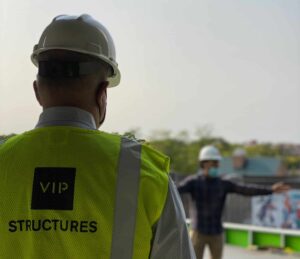Our objective in creating design-build teams is always unity. When a team of people form to execute huge construction projects, it is critical to have everyone on the same page. The design-build team knows the scope and parameters of each project so there is no question about the goals to be accomplished. Along the way checkpoints are addressed as well as the progress of the end goal. The right team members working toward a common goal in conjunction with the project owner will consistently deliver success.
Design-build defined
In a design-build agreement, a project is delivered via the design-build team under one contract covering both design and construction services. This contract of work extends from concept to completion, as opposed to the more traditional design-bid-build method that consists of separate contracts by separate parties.
The elements of design-build
Each design-build project should include the following elements in order to succeed:
- A well-crafted definition of the scope of work for the project
- Explicit responsibilities defined for team members
- Measurement criteria for benchmarks
- A confident project owner capable of quick, sound decision-making
- Experienced team members committed to the success of a project
Building to completion
A design-build team includes the team leader who is the liaison for the project’s owner and is typically the team member authorized to make resource commitments, and legal and financial agreements related to the project. The general contractor is typically designated as team leader but an engineer, architect, or other party may be designated. The team is completed with design professionals (engineers and architects), as well as build experts (contractors and construction workers). At VIP, we refer to this as the Project Executive (PX).
An effective design-build process aligns team members from the various disciplines early in the process. This allows for thorough understanding of the project at the onset while minimizing risk and protecting the overall project budget as the work extends. Team members working in the design-build concept form positive alliances, helping to ensure professional collaboration. When united in a goal under one vision, a design-build team can deliver a project more cost effectively, quicker, and with fewer change orders.
The steps to design-build completion
1) An initial meeting is held between the client and contractor to determine the following:
- Project objectives and goals (Budget)
- Client Priorities
- Professional service options and pricing
- Understanding of next steps
2) A design meeting introduces the designer or architect to the owner with discussion on:
- Clarification of project objectives and goals
- Client preferences
- Architect or designer qualifications
- Project overview and budget
- Design agreement and fees
- Any special interests and priorities
3) A follow-up design agreement meeting takes place for:
- Discussion and signing of the Design Agreement
- Establishment of the design program
If the process is a renovation of an existing building, during a field measurement meeting the following steps are taken:
- Field measurements taken for preliminary drawings
- Survey requirements identified
4) A client meeting is held to discuss:
- Preliminary design drawings
- Contractor, architect, and client concerns/opportunities
- Preliminary costs vs. budget
- Allowances and changes
5) Construction drawings are prepared based on the client’s product selections with input from the architect, designer, and contractor, and governing codes and necessary agency reviews.
6) The final project bid is prepared and submitted:
- Final bids created by major subcontractors
- Final costs on products and other selections
- Client discussion to review drawings and costs/options
- Finalize scope of work
After financing is approved, the contractor’s contract is signed and the contractor submits subcontractor and vendor lists. A pre-construction conference is held to discuss the schedule, which is then maintained through regular benchmarking meetings.
The schedule in a design-build process is facilitated because of the single point of contact and accountability on every facet of a project. Because of its collaborative nature, the design-build process eliminates the time that is typically lost between design, permit, and construction schedules, focusing instead on the client in realized savings and other efficiencies.
Your design-build team at VIP Structures
When you work with VIP, you have an entire organization of experts in architecture, engineering, construction, and development on your team. The whole team communicates with you through a single point of contact. This approach not only delivers the right expertise at the right time throughout the build process, it also empowers you to make informed and timely project decisions.
Our team members all work under one roof, allowing for quick resolution of problems and collaborative solutions that save time and money, as well as delight our clients. We are also driven to come in at, or under, budget for our customers’ projects. We can do that because we look at each one from not only the development perspective, but also from the owner’s. This integrated, inclusive way of working takes projects to levels that just aren’t possible in more fragmented processes.
At VIP Structures, we have been using the design-build team concept for over 40 years and can attest to superior quality, reduced risk, improved project delivery speed and significant cost savings for our clients.



